Fiction and Poetry
Fire Tongue
Zvi A. Sesling (COM’66)
Červená Barva Press
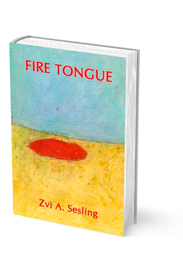 When a poetry collection’s most comforting verse is titled “The World Is Ending,” you know you’re in for some pretty dark reading. Death not only pervades these verses, it is the scaffolding they cling to. It is the fuel for irony, bitterness, faith, and redemption, and in these poems, all that thrives in life does so with the sad insistence of a barnacle on a dying reef.
When a poetry collection’s most comforting verse is titled “The World Is Ending,” you know you’re in for some pretty dark reading. Death not only pervades these verses, it is the scaffolding they cling to. It is the fuel for irony, bitterness, faith, and redemption, and in these poems, all that thrives in life does so with the sad insistence of a barnacle on a dying reef.
No one is spared: cars mow down blameless children, a hydrogen bomb rains on a city. In the poem “Last Will,” the grieving relatives, likened to vultures, lean in close to hear a dying man’s last words: “Screw you all!” One poem is titled, simply, “Death.”
Divided into four sections, “Fire Tongue,” “City,” “Sorrow Road,” and “War Zones,” the poems range from intimate to historical, including “Texas Tower Massacre,” which ponders the psyche of the 25-year-old man who shot dead 14 people at the University of Texas in 1966:
Crush the people like cockroaches on sidewalks
bullets in place of feet, hands steady rifle
do you—feel close to God or Satan in the tower
up there pulling the trigger again and again
A widely published poet who has taught at Emerson College as well as Boston University, Sesling has created in Fire Tongue an affecting landscape of loss, fear, and decay. Some of the poems, such as “Hotel Terminus,” read like a warning and could have been penned by a mischievous Death itself. The shorter poems deliver swift stabs to the gut, such as this, from “Hours Gray and Ill”:
Sadness pervades
black night, stars hide
from illness of dark
By embracing something so fundamentally and universally human—death and fear of death—Sesling’s poems whisper in the reader’s ear that although there is no escape, he or she is not alone, and that for all its inevitability, death is oblivion, and we are right to be, to varying degrees, obsessed with it.—Susan Seligson
Nonfiction
Casting Lots: Creating a Family in a Beautiful, Broken World
Susan Silverman (CAS’85)
Da Capo Press
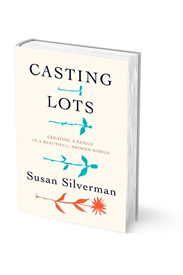 Reading Silverman’s Casting Lots is like spending time in the company of a wise, funny, and generous friend. Although the subtext is a call to international adoption (there are tens of millions of orphans in the world, Silverman, whose resource website is JustAdopt.net, tells us), the book is on many levels a love story. An ordained rabbi, a human rights activist, and an adoption advocate, Silverman takes us through a childhood in a family so blended that her parents’ divorce was not a loss, but ultimately a windfall in the form of stepparents (and a half sibling) who feel devotion to their children, biological or not, and relaxed affection for one another. It’s a portrait of a sometimes achingly honest marriage where dinner table discussion can take on the weightiness of a Talmudic argument. It’s about an extended family of loquacious, cheek-pinching kvellers who cannot get enough hugs, kisses, or laughs.
Reading Silverman’s Casting Lots is like spending time in the company of a wise, funny, and generous friend. Although the subtext is a call to international adoption (there are tens of millions of orphans in the world, Silverman, whose resource website is JustAdopt.net, tells us), the book is on many levels a love story. An ordained rabbi, a human rights activist, and an adoption advocate, Silverman takes us through a childhood in a family so blended that her parents’ divorce was not a loss, but ultimately a windfall in the form of stepparents (and a half sibling) who feel devotion to their children, biological or not, and relaxed affection for one another. It’s a portrait of a sometimes achingly honest marriage where dinner table discussion can take on the weightiness of a Talmudic argument. It’s about an extended family of loquacious, cheek-pinching kvellers who cannot get enough hugs, kisses, or laughs.
Silverman has always wanted and planned to be a mother, and for as long as she can remember, that plan included adoption. In her husband, Yosef Abramowitz (CAS’86), she finds a thoughtful, devout, and optimistic partner whose progressive brand of Judaism fuels his commitment to the notion of tikkun olam—healing the world. “I want to adopt from abroad,” Silverman declares to Abramowitz. “And I don’t mean from a lady.” At the time, they have two young biological daughters. Ethiopia, writes Silverman, seems a perfect choice—Abramowitz had been active in bringing Ethiopian Jews to Israel.
It was agreed the child would be a boy. “Girls come from mommy’s tummy and boys come from Ethiopia,” evolves into a family mantra. And so the family grows, as Susan returns home from an Addis Ababa orphanage cradling the infant Adar, and years later returns to adopt three-year-old Zamir. The boys join daughters Aliza, Hallel, and Ashira.
Silverman has been bargaining with God since childhood, when as a toddler, before the birth of her sisters, she found herself in the sad, confusing vacuum left by a brother killed in a freak accident at six months old. By Silverman’s account, the tragedy’s potentially devastating psychic fallout—lifelong guilt, blame, rage—didn’t materialize. Instead, the virtues of forgiveness, resilience, and gratitude triumphed. But the flip side of such profound and terrifying love is fear of loss, and she has wrestled with anxiety her entire life.
The book concludes with the family’s emigration from the United States to a kibbutz in Israel’s Negev Desert. There, they found simplicity, community, and the progressive, pluralistic values they hold so dear. Casting Lots, a reference to the Old Testament’s mention of a kind of throw of the dice to determine God’s will, is subtitled Creating a Family in a Beautiful, Broken World. But it is not until her author’s note at the end that Silverman lays out the case for international adoption as a way of making that world, ever so slightly, more beautiful and less broken. She debunks the common arguments against international adoption. But an even more powerful argument resides in the montage of Silverman-Abramowitz family snapshots that appears in the book. Guided by their own instincts and beliefs and fueled by their love for one another and the planet, they made a family. And it was good. —SS
The Fire Line: The Story of the Granite Mountain Hotshots and One of the Deadliest Days in American Firefighting
Fernanda Santos (COM’99)
Flatiron Books
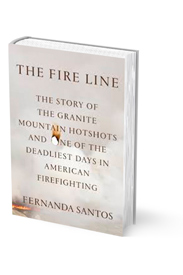 In her job as New York Times Phoenix bureau chief, Santos was tasked with covering the tragic June 2013 wildfire that killed 19 elite firefighters in one day. Their deaths marked the single greatest loss of firefighters nationwide since 9/11, and the largest death toll of professional wildland firefighters in more than a century.
In her job as New York Times Phoenix bureau chief, Santos was tasked with covering the tragic June 2013 wildfire that killed 19 elite firefighters in one day. Their deaths marked the single greatest loss of firefighters nationwide since 9/11, and the largest death toll of professional wildland firefighters in more than a century.
She took an eight-month leave from the Times to write her first book, The Fire Line. The story reads as if Santos tagged along with the Granite Mountain Hotshots in the field, but in fact, she never met them. She relied heavily on interviews with their families and friends to flesh out her characters. She interviewed scientists and climate experts as well. Wildfires, she writes, are becoming more prevalent because of climate change and increased urban development. She spent part of 2014 training at the Arizona Wildlife and Incident Management Academy to learn how to fight fires.
Santos dives deep into who these men were, sharing intimate details about their quirks, families, and bonds with their comrades. The wildfire that killed the men grew fast. Santos stresses that the men stuck together until the end, describing how their bodies were found in a tight formation, huddled under portable aluminum fire shelters that begin to disintegrate at 500 degrees. The fire clocked in at 2,000 degrees, as hot as lava from a volcano, she writes, and the shelters couldn’t stand up.
The Granite Mountain Hotshots, writes Santos, “had chosen to live on a razor’s edge, helped one another elect and survive constructive risk, and rewarded one another with well-founded guardianship and devotion.” —Amy Laskowski
In Other Words
Jhumpa Lahiri (GRS’93, UNI’95,’97)
Alfred A. Knopf
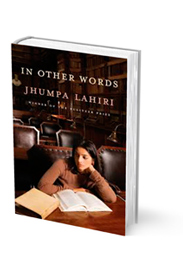 Lahiri was just 32 when she won the 2000 Pulitzer Prize for her first book, the short story collection Interpreter of Maladies. Since then, she has written two well-received novels, The Namesake and The Lowland, as well as another collection of stories, Unaccustomed Earth, each vividly depicting the Indian diaspora.
Lahiri was just 32 when she won the 2000 Pulitzer Prize for her first book, the short story collection Interpreter of Maladies. Since then, she has written two well-received novels, The Namesake and The Lowland, as well as another collection of stories, Unaccustomed Earth, each vividly depicting the Indian diaspora.
In Other Words is altogether different: a slim memoir that at its heart is a love story. And like any love story, this one is full of passion, longing, and at times, exasperation. But Lahiri’s affair is with the Italian language.
“It was love at first sight,” Lahiri writes, recalling her first trip to Italy in 1994 while she was working on a PhD in renaissance studies at BU. “My relationship with Italy is as auditory as it is visual….What I hear in the shops, in the restaurants, arouses an instantaneous, intense, paradoxical reaction. It’s as if Italian were already inside me.”
Over the next 18 years, Lahiri studied the language as she raised her family and built a literary career. But after completing The Lowland, in 2013, she felt that she had come to the end of a certain creative phase in her writing life. In Other Words begins with her decision to move with her husband and two children from Brooklyn, N.Y., to Rome, so she could read and write full time in Italian.
In some of the memoir’s most moving passages, Lahiri chronicles her complicated relationship with language. She spoke only Bengali until she was four, when her family moved to Rhode Island from India (by way of England). Her first encounter with English, she writes, “was harsh and unpleasant.” She describes how hard it was to trust teachers and make friends, “because I had to express myself in a language that I didn’t speak, that I barely knew….I was ashamed of speaking Bengali and at the same time, I was ashamed of being ashamed.” As she notes, “Writing in Italian offers a flight from that conflict.”
Lahiri wrote the book in Italian; the English version is presented in a dual-language format, with her Italian text appearing on the left page and the English translation, by Ann Goldstein, on the right.
In Other Words ends with Lahiri and her family about to return to the United States after a three-year absence. But thanks to this project, she writes, “a piece of me can remain in Italy.” —John O’Rourke



































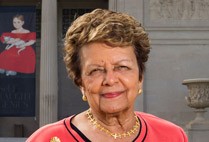









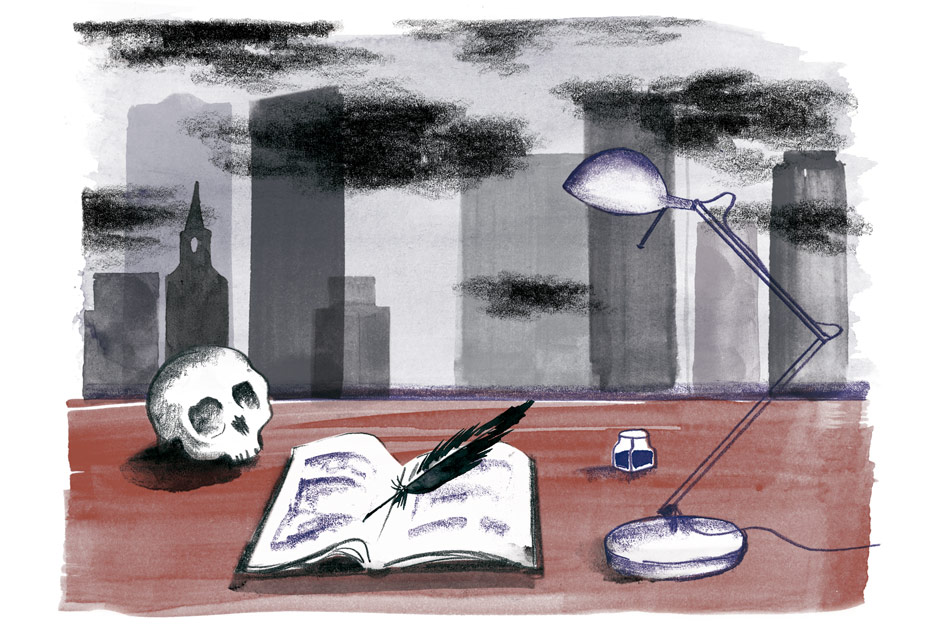
 When a poetry collection’s most comforting verse is titled “The World Is Ending,” you know you’re in for some pretty dark reading. Death not only pervades these verses, it is the scaffolding they cling to. It is the fuel for irony, bitterness, faith, and redemption, and in these poems, all that thrives in life does so with the sad insistence of a barnacle on a dying reef.
When a poetry collection’s most comforting verse is titled “The World Is Ending,” you know you’re in for some pretty dark reading. Death not only pervades these verses, it is the scaffolding they cling to. It is the fuel for irony, bitterness, faith, and redemption, and in these poems, all that thrives in life does so with the sad insistence of a barnacle on a dying reef. Reading Silverman’s Casting Lots is like spending time in the company of a wise, funny, and generous friend. Although the subtext is a call to international adoption (there are tens of millions of orphans in the world,
Reading Silverman’s Casting Lots is like spending time in the company of a wise, funny, and generous friend. Although the subtext is a call to international adoption (there are tens of millions of orphans in the world,  In her job as New York Times Phoenix bureau chief,
In her job as New York Times Phoenix bureau chief, 


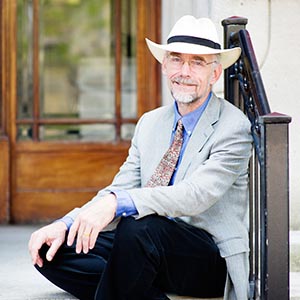
The choice of books is singular, the reviews intelligent and I am stunned by the insight and accuracy of Zvi Sesling’s book. Thank you.